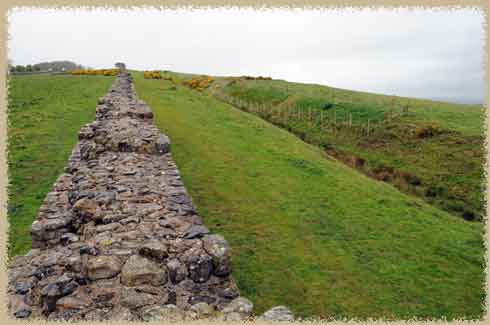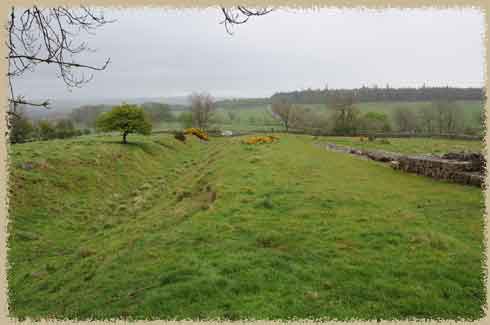Hadrian's Wall
Driving and walking along Hadrian's Wall, on the border of Scotland, and the only thing that I can think is, 'wow, they were terrified of these northern barbarians', to put so much effort into creating a physical barrier to keep them from coming south. They must have been terrified of fhe tribes up here.
Not to mention, this is remote place -- in the second century, this would be the far northern reaches of the Roman Empire, far from the warm, sunny shores of Rome. Posting out here would be ..well, I guess I'd probably consider it punishment, or at least getting farmed out so far I coudln't do any damage.

the remains of the wall and ditch of Hadrian's Wall
Walking the Wall
It's possible to "walk the wall" from coast to coast, seeing each of the forts in turn and enjoying the spectacular countryside of Northumberland. Well, spectacular when it's not raining (or, well, that's spectacular, too, but makes the walking a lot less fun).
This is not the only Roman wall in Britain (the Antonine wall is further north) but it is the best preserved. It is still a remarkable structure -- the most heavily fortified border that Rome ever built. Even now, there are long stretches that remain (much of them reconstructed), but the ditch system along the wall is visible nearly the whole length.

The wall is almost 75 miles long (Wiki says 80 "roman miles") and anywhere from 10-20 feet hight depending on the construction method used for any given span. The wall was usually stone, but in some cases was simply turf. Forts and towers every mile or so (the "mileforts" allowed the garrison to actually control the border, althougn it wasn't raelly meant to keep people from passing entirely, or to defend against a major military invation, it was more of a 'visible threat' to remind people that the Romans were here.
Building Plans
The wall was started sometime in 122 CE and took about six years to complete (one of the advantages of having thousands of soldiers, and I assume slaves, to put to work.). The road began from the east and followed the Stanegate road, which already had a number of forts. it is apparently possible to identify which Roman legion built which part of the wall and which forts -- they are slightly different styles.


